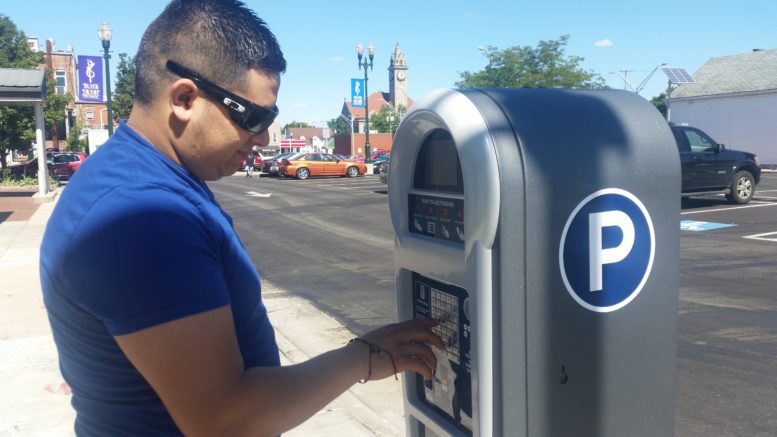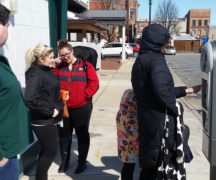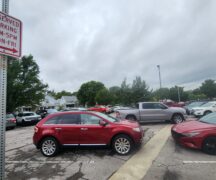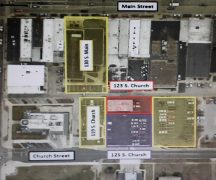By JAN LARSON McLAUGHLIN
BG Independent News
Bowling Green leaders have two months to solve downtown parking issues until their time expires. When the time is up, the cost of parking meters will double in the downtown area if a solution isn’t found.
On Tuesday evening, Bowling Green City Council Committee of the Whole listened to a proposal for sharing the costs of parking downtown.
This proposal – unlike the initial idea to double meter costs to 50 cents an hour – suggests that all parking meters and kiosks be pulled out, and downtown property and business owners be assessed for parking costs.
The problem is that the city isn’t making enough from its downtown parking meters to pay for repaving the lots and enforcing parking rules. But the fear is that doubling parking costs will discourage customers from patronizing downtown businesses.
The city’s downtown lots – with their 600-plus parking spaces – are struggling due to flat revenue, increasing costs and aging infrastructure. So the options suggested last month included increasing the parking revenue, sharing the costs of maintaining the parking lots, or getting rid of some of the expenses.
Other Ohio college communities such as Kent and Oxford charge up to $1 an hour for parking. Toledo charges at least 50 cents per hour. However, no parking meters are used in Perrysburg, Defiance, Waterville, Findlay or Maumee.
Tuesday on City Council’s agenda was the third reading of an ordinance increasing the parking rates. Council agreed to table that ordinance to give a task force time to discuss other options. Council President Mike Aspacher suggested that the task force include downtown property owners and business owners.
“It’s a critically important component in the success of our community,” Aspacher said.
Council member Greg Robinette stressed the need for the group to work quickly, since the parking kiosks in the lot behind Panera need to be updated by December if the city continues to use the kiosks there.
“I’d like to force us to move the process along,” Robinette said, suggesting that the task force be limited to two months.
“Time is ticking,” said council member John Zanfardino.
The city also needs to repave downtown parking lots 1, 3 and 4. That is estimated to cost $400,000. Under a shared cost program, the downtown property owners would be assessed based on their front footage and the benefits to their parcels. The average property owner would pay $220 a year for 20 years. The lowest amount charged would be $30 a year. The highest – to the owner of multiple properties – would be $2,000 a year.
Those assessments would generate about $20,000 a year.
The concept of the downtown property owners picking up the tab for parking expenses was not supported by the landowners during a meeting earlier this year. However, the business owners attending the last council meeting stated they would be willing to share in the expenses if it meant customers wouldn’t have to pay for parking.
Aspacher and council members Bruce Jeffers and Sandy Rowland stressed the need for business owners to be included in the conversations – not just the property owners.
“We need to make sure they are both on the same page,” Aspacher said.
While parking would be free to motorists under this proposal, there would still be limits on the amount of time a parking spot can be used.
“Turnover in parking in the downtown is very important to business vibrancy,” said Municipal Administrator Lori Tretter.
Because of concerns about the current two-hour limit not being enough time to shop and dine in the downtown, the new proposal calls for a three-hour limit. It also suggests that the $5 parking fine be increased to $15 for those motorists who overstay their time.
“We want to work with our downtown partners on this,” Tretter said.
So the city would still need to employ its two parking technicians. In fact, the proposal suggests that the enforcement periods be expanded into the evenings and on weekends.
Tretter warned that some motorists will likely be confused by the fact that they don’t have to pay for parking, but that time limits are still enforced. The downtown parking lot with kiosks has 33 signs instructing motorists, “and we still hear from people all the time,” that they had no idea they had to pay for parking, Tretter said.
The benefits of getting rid of parking meters would be multi-faceted, Tretter said. It would be a marketing opportunity for downtown businesses, it would eliminate the need for meter or kiosk replacements, and it would mean the city would no longer have to pay property taxes on the parking lots since they would not be generating revenue. That alone will be an annual savings of about $35,000.
However, the elimination of parking meter revenue could have a negative impact on the city’s general fund, Tretter said.
The city currently sells 116 parking permits annually downtown for apartment tenants and businesses. It has not been decided how those will be handled.
Council member Bill Herald suggested that the city slow down and make sure it considers all of the possible parking options.
“It has a long-lasting and significant impact” on the city budget and downtown viability, he said.
But other council members felt some urgency, since the parking budget is already facing a deficit, and the need for kiosk updates is near.
Two years ago, the city attempted to move toward the newer trend of parking kiosks. While some like the change, others have difficulty using the kiosks and avoid that parking lot. Those kiosks cost $12,000 each.
“We hate to buy new kiosks if we go with shared costs of free parking,” Jeffers said.





